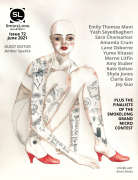In “Too Long Under Water,” you weave a textural and emotional narrative using real and imagined crocodiles, evoking the urgency of an implied ticking clock. How did you find your way into this story?
My stories are often rooted in memory—lingering moments of fear, excitement and discovery that become the patchwork of our adult selves. As a child, I visited a zoo with a crocodile just like Buster. That deadly stillness held me in thrall. I carried around the image, that feeling of wrongness, for years, before finding a route into this piece. The start and end remained intact throughout edits but when this unexpected character, Uncle Billy, pressed the coin into the child narrator’s hand—that’s when the story emerged.
You create what Robert Olen Butler calls an “omnisensual cinema” by employing a close lens on the trajectory of that seven-sided coin. The crocodile parallelism, along with reptilian alliteration, heightens our fear. How do sensory description and sound influence your work?
Sensory recollection is a powerful tool for writers. I have a sieve-like memory for facts, yet I recall childhood scenes in vivid detail—the layout of my infant school classroom, the feel of sticky glue between my fingers, the whistle of a stovetop kettle. Lengthy description can weigh a story down, but not if pressed into double duty. In this story the coin carries the story arc, while also bearing emotional and symbolic weight, and Billy becomes reptilian.
Rhythm and sound matter, too. When editing, I try not to interfere too much with the natural rhythm of early drafts. I consider the sound words make and their narrative impact. Breathing space in the text allows readers to develop their own trails of thought. Stories are conversations, really.
The opening and final images elicit childhood sense-memories of long-held coins. What is your approach to achieving emotional resonance?
Central to my teaching is the idea of making writing particular, making the familiar feel new. I’m drawn to museums, old books, photographs and objects, unexpected sights and overheard snippets of conversation. Interesting things happen where thoughts collide. Sometimes, I’ll read something that turns an anchorless idea into a meaningful narrative. Prompts that trigger memories—of places, objects, feelings—tend to result in emotionally resonant stories. A story might stray far from memory, but if the original emotion is retained, the writing will be richer for it.



 The SmokeLong Grand Micro Contest (The Mikey) is now an annual competition celebrating and compensating the best micro fiction and nonfiction online.
The SmokeLong Grand Micro Contest (The Mikey) is now an annual competition celebrating and compensating the best micro fiction and nonfiction online.